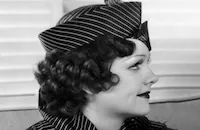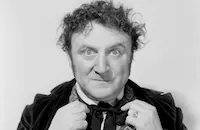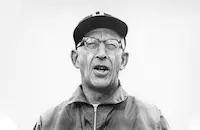The Bowery

Brief Synopsis
Cast & Crew
Raoul Walsh
Wallace Beery
George Raft
Jackie Cooper
Fay Wray
Pert Kelton
Film Details
Technical Specs

Synopsis
In the Gay Nineties, on New York's Bowery, known as the "livest mile on the face of the globe," Chuck Connors, the owner of a saloon which boasts the "largest schooner of beer," finds that his rival, Steve Brody, has thrown a mushmelon at his window. After the happy-go-lucky Steve explains that he threw the melon on a dare, Chuck is about to fight him when they learn of a fire in Chinatown. Both men call upon their volunteer fire brigades, and they wager $100 on which will be the first to throw water on the fire. Although Steve gets there first, he finds Chuck's young pal, Swipes McGurk, sitting on a barrel over the fire hydrant so that Chuck's brigade can use it first. The rival fire fighters get into a tremendous fight and soon lie scattered in the street and gutters as the fire reduces the building to a smoldering ruin. Steve vows to get even, but when two hoodlums, Slick and Googy from Jersey City, offer to kill Chuck for $500, Steve fights them. When Chuck becomes the manager of heavyweight prizefighter Bloody Butch, Steve bets Chuck $500 that his own fighter, whom he calls "The Masked Marvel," can beat him. After the "Marvel" knocks out Bloody Butch with one punch, he is revealed to be boxing legend John L. Sullivan. When Chuck sees a naïve girl, Lucy Calhoun, about to accept a proposition from Slick and Googy, he warns them not to "hawk" girls in his place. Lucy thanks Chuck and explains that she is homeless and looking for work. Chuck takes her to his apartment, where he lives with Swipes, and lets her sleep there. In the morning, he is pleasantly surprised, while Swipes is annoyed, to find that Lucy has cleaned up the place and cooked breakfast. Later, Chuck finds that Swipes has locked Lucy in a closet and spanks him. Humiliated before Lucy, Swipes packs and leaves. That night, Steve invites Swipes to move in with him. Steve then tries to make love with Lucy, thinking she is Chuck's mistress. She bites his hand, drawing blood, and after he apologizes, he asks if he can call on her. They soon fall in love, and Steve reveals his ambition to run a saloon bigger than Chuck's. When two brewers offer to back him if he can bring his name into prominence, Steve decides to jump off the Brooklyn Bridge as a stunt. After Chuck bets his saloon against a free burial that Steve won't make it alive, Steve gets a life-sized dummy made up to look like him and arranges for Swipes to throw it off the bridge at the time of the jump. As an estimated crowd of 100,000 gathers at the bridge, Swipes finds the dummy missing. Despite Swipes's pleas, Steve vows to make the jump anyway, so that no one can say he didn't take a dare. Meanwhile, Chuck tries to calm down Carrie Nation and her band of women, who have come to tear down his saloon with axes and hatchets. When he sees Steve lifted in a parade after making the jump, however, Chuck encourages the reformers to destroy the saloon, which they do. Steve soon opens the saloon again, and when war is declared against Spain, Chuck enlists to get away from the Bowery, where he is no longer a big shot. When he returns to his apartment to pack, he finds that Swipes has moved back. After Slick and Googy tell Chuck that Steve did not jump from the bridge and show him the dummy, Chuck demands his saloon back. Steve denies using the dummy, and they have a long fight on a barge in the river to settle their differences. After Chuck returns victorious, he is arrested for assault and battery with intent to kill. Steve, however, refuses to implicate him. In Steve's hospital room, he and Chuck begin another fight, but Swipes stops them and urges them to become friends. After they shake hands, Chuck dares Steve to join him in Cuba. At a parade for departing soldiers, Chuck tells Lucy to kiss Steve goodbye, and after she does, she also kisses Chuck. The men lament not being able to say goodbye to Swipes, but they soon see, to their delight, that he is hiding in an artillery box on the supply wagon just ahead of them.

Director

Raoul Walsh
Cast

Wallace Beery

George Raft

Jackie Cooper

Fay Wray

Pert Kelton

Herman Bing
Oscar Apfel
Ferdinand Munier
George Walsh
Lillian Harmer

Charles Lane

Harold Huber
Fletcher Norton
John Kelly
Esther Muir
John Bleifer
Tammany Young
Frank Moran
Fred Behrle
Willie Keeler
Harry Wardell
Mr. Hardigan
Harry Shutan
Phil Brady
Fireman Jim Flynn
Al Mccoy
Kid Broad
Spike Robinson
Crew
Kenneth Alexander
Hal Carney
Don Carstenson
Don Carstenson
Ray Curtiss
Richard Day
Ed. Ebele
Howard Estabrook
Bill Forsyth
Fred Fox
James Gleason
Bert Glennon
William Goetz
Don Greenwood
Hugo Grenzbach
Raymond Griffith
L. Hafley
Jack Haskell
Tex Hayes
Barney Mcgill
Allen Mcneill
Russell Metty
Alfred Newman
Jack Noyes
Peg O'neil
Don Oswald
Joseph M. Schenck
Stuart Thompson
Harry Webb
Darryl F. Zanuck

Film Details
Technical Specs

Articles
Fay Wray (1907-2004)
She was born Vina Fay Wray, in Cardston, Alberta, Canada on September 15, 1907. Her family relocated to Arizona when she was still a toddler so her father could find employment. When her parents divorced, her mother sent her to Hollywood when Fay's eldest sister died in the influenza epidemic of 1918. The reasoning was that Southern California offered a healthier climate for the young, frail Wray.
She attended Hollywood High School, where she took some classes in drama. After she graduated, she applied to the Hal Roach studio and was given a six-month contract where she appeared in two-reel Westerns (25 minutes in length), and played opposite Stan Laurel in his pre-Oliver Hardy days.
She landed her first big role, as Mitzi Schrammell, in Erich von Stroheim's beautifully mounted silent The Wedding March (1928). It made Wray a star. She then starred in some excellent films: The Four Feathers (1929), the early Gary Cooper Western The Texan (1930), and one of Ronald Coleman's first starring roles The Unholy Garden (1931), all of which were big hits of the day.
For whatever reason, Wray soon found herself in a string of thrillers that made her one of the great screamers in Hollywood history. The titles say it all: Doctor X, The Most Dangerous Game (both 1932), Mystery of the Wax Museum, The Vampire Bat (both 1933) and, of course her most famous role, that of Ann Darrow, who tempts cinema's most famous ape in the unforgettable King Kong (also 1933).
Wray did prove herself quite capable in genre outside of the horror game, the best of which were Shanghai Madness with Spencer Tracy; The Bowery (both 1933), a tough pre-Hays Code drama opposite George Raft; and the brutal Viva Villa (1934), with Wallace Beery about the famed Mexican bandit. Yet curiously, the quality of her scripts began to tank, and she eventually found herself acting in such mediocre fare as Come Out of the Pantry (1935), and They Met in a Taxi (1936).
With her roles becoming increasingly routine, the last of which was the forgettable comedy Not a Ladies Man (1942), she decided to trade acting for domesticity and married Robert Riskin, who won two Best Screenplay Oscars® for the Frank Capra comedies It Happened One Night (1934) and Mr. Deeds Goes to Town (1936). When Riskin died in 1955, Wray found herself working to keep busy and support her three children. She landed supporting parts for films like The Cobweb (1955), Hell on Frisco Bay (1956) and Tammy and the Bachelor (1957). She also found work in television on such popular programs as Perry Mason and Wagon Train before she retired from acting all together in the mid-'60s.
To her credit, Wray did remain reasonably active after her retirement. She published her autobiography, On The Other Hand in 1989 and was attending many film festivals that honored her contribution to film, most notably in January 2003, when, at 95 years of age, she accepted in person her "Legend in Film" Award at the Palm Beach International Film Festival. Wray is survived by a son, Robert Riskin Jr.; two daughters, Susan and Victoria; and two grandchildren.
by Michael T. Toole

Fay Wray (1907-2004)
Quotes
Trivia
Notes
Screenwriter Howard Estabrook's name is incorrectly spelled "Esterbrook" in the onscreen credits. This was the first film produced by Twentieth Century Pictures, which Time called "the first important new producing company formed in Hollywood in four years." The company, which in 1935 merged with Fox to form Twentieth Century-Fox Film Corp., was established in late April 1933 by Darryl Zanuck, who became vice-president in charge of production, and Joseph Schenck, who became president. Zanuck, who had been in charge of production at Warner Bros., resigned from that company effective April 15, 1933, according to news items, following a dispute concerning the studio's refusal to back up his promise to employees to restore their salaries to their full amount following a fifty percent cut due to the industry's financial crisis. The announcement to the press of the formation of the company stated that they would produce stories of the "modern headline type." Hollywood Reporter wrote that this film marked "probably the most auspicious start any motion picture company ever received." According to news items, the film broke attendance records in Los Angeles, San Francisco and Washington, D.C.
According to material in the Twentieth Century-Fox Produced Scripts Collection at the UCLA Theater Arts Library, the unpublished novel was originally submitted to Zanuck at Warner Bros. in 1932. At that time, Zanuck's associates did not think the material would be worth producing. Raymond Griffith, who subsequently was an associate producer of the film, commented in an inter-office memo to Zanuck, "This is the life story of Chuck Connors. Why it was written I don't know because he was of no importance. He was merely an illiterate fool that wore a ridiculous costume and was a guide through Chinatown. He was connected with nothing of importance in his period; he wasn't even an important hoodlum of the day. I do not see anything of consequence in this at all." Lucien Hubbard, a producer at Warner Bros., commented, "Considered as a story, this is pretty bad....I consider this offers nothing but the chance to write an original story about a character." Production executive Hal B. Wallis noted, "It would be a very expensive picture to make." According to information in the Produced Scripts Collection, "Swipes" was really not as young as he is in the film; the suspicion that Steve Brody used a dummy to fake the jump off the bridge was a legend on the Bowery; Brody owned a bar in which hung a painting of his jump, as in the film; and Chuck Connors never did own a saloon.
According to news items, Paramount was going to withdraw Raft, whom they loaned for the film, because of a conflict in schedule. M-G-M then loaned Clark Gable for the role of Brody, but Raft eventually acted the role. Los Angeles Times noted, "It is reported that a dicker is on for Clara Bow to play [the role of Carmencita]," a dancer, whom Los Angeles Times noted was one of the first personalities ever to be seen in a motion picture. That role either was changed in the final film or removed completely. According to material in the Produced Scripts Collection, some scenes were shot at the pier at Playa del Rey, CA. According to news items, in October 1933, Chuck Connors, Jr. filed a libel suit to have the film's exhibition stopped because of the portrayal of Connors. Subsequently, a Hollywood Reporter news item reported that Connors, Jr. "most likely is not the son of Chuck Connors," and that the judge in the case encouraged the defendant to bring charges of perjury against him. In November 1933, Mrs. Elizabeth Clark, really a daughter of Connors, intimated that she would file suit. No further information about her court action has been located.














